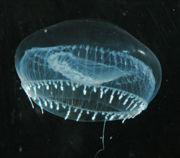Aequorea victoria
From ize
Aequorea victoria commonly called the Crystal Jelly is a translucent hydrozoan jellyfish. It is very abundant in the eastern North Pacific Ocean, and can be found in the south Puget Sound from spring to fall.
| Taxonomy | |
|---|---|
| Kingdom: Animalia | |
| Phylum: Cnidaria | |
| Class: Hydrozoa | |
| Order: Hydroida | |
| Suborder: Thecata (Leptomedusae) | |
| Family: Aequoreidae | |
| Genus: Aequorea | |
| Species: A. victoria |
Contents |
Size
Ranging from 5 to 12 cm in diameter
Description
Almost entirely clear and sometimes difficult to resolve, Aequorea victoria possess a highly contractible mouth & manubrium at the center of up to 100 radial canals that extend to the bell margin. The bell margin is surrounded by up to 150 uneven tentacles in full-grown specimens. The tentacles possess nematocysts that aid in prey capture, though they have no effect on humans. Specimens larger than 3 cm frequently possess gonads for sexual reproduction (visible in all photos), which run most of the length of the radial canals. The bell margin is ringed with a small velum, typical of most hydromedusae, which aids in locomotion through muscular contraction of the bell. Larger specimens are frequently found with symbiotic amphipods attached to the subumbrella.
Species Range
Aequorea victoria are found along the west coast of the Pacific ocean from the Bearing Sea to southern California. A pelagic organism, it can be found floating and swimming both nearshore in the Puget sound, as well as offshore in the eastern Pacific Ocean[1].
Misidentifications
Aequorea victoria can be mistaken for other species from the Aequorea genus, notably Aequorea coerulescens. While this species is found generally offshore in the eastern Pacific Ocean, rare specimens have been collected in central California and in Friday Harbor, North Puget Sound[2]. While morphologically very similar to Aequorea victoria, Aequorea coerulescens is roughly the size of a dinner plate with many more radial canals.
Life History
Aequorea victoria have a dimorphic life history, alternating between asexual benthic polyps and sexual planktonic medusae in a seasonal pattern[3]. Aequorea victoria juvenile medusas are asexually budded off hydroid colonies in early spring, and soon become free-living hydromedusaes. The medusoid spends its first segment of life growing quickly, and after reaching approx. 3 cm will begin producing gametes for sexual reproduction. These eggs are free-spawned into the water column around mid August, where they eventually settle out to form a new hydroid colony. These thrive on hard or rocky substrates on the bottom, where they overwinter until an unknown cue spurs them to continue the cycle with a new generation. The medusa form generally lives approximately 6 months[4].
Natural History
Aequorea victoria typically feed on soft-bodied organisms, including zooplankton such as copepods, crab zoeas, barnacle nauplii & other larval planktonic organisms. Gelatinous organisms consumed include ctenophores, appendicularians and other hydromedusae, including other Aequorea victoria and Clytia gregaria if conditions are appropriate[5]. Prey is ensnared in long tentacles containing nematocysts, and eaten with a highly contractile mouth that can expand to consume organisms half the medusae’s size. Due to their voracious nature, Aequorea victoria density can be inversely correlated to zooplankton density, indicating their predatory dominance in competetive environments[6].
Predators
They are eaten by the voracious scyphozoa Cyanea capillata, commonly called the Lion’s Mane Jelly, as well as ctenophores, siphonophores and other hydromedusae, including documented cases of cannibalism[7]. Many larger specimens are found with the parasitic hyperiid amphipod Hyperia medusarum attached to the subumbrella.
Luminescence
Like many hydromedusae, Aequorea victoria possess luminescent photophores around the bell margin that flash or glow green when distressed. These photophores carry the blue fluorescent protein Aequorin, as well as Green Fluorescent Protein (GFP), another fluoresecent protein that transforms the blue light from Aequorin into a green fluorescent light. It is possible to induce a bioluminescent response in Aequorea victoria by holding the medusae and lightly shaking it. The photophores will respond, giving off their characteristic green glow[8]. Since the discovery of aequorin and Green Fluorescent Proteins (GFP) by Shimomura and Johnson[9], species of Aequorea victoria have been extensively harvested around Friday Harbor, San Juan Islands for use in luminescence studies, as well as in biomedical research for its potential for data storage[10], and in neurological research to detect the presence of calcium[11]
Footnotes
- ↑ Kozloff, Eugene N.. Marine Invertebrates of the Pacific Northwest. 2nd. Seattle: University of Washington Press, 1996.
- ↑ Mills, C.E. 1999-present. “Bioluminescence of Aequorea, a hydromedusa.” Electronic internet document available at http://faculty.washington.edu/cemills/Aequorea.html. Published by C. E. Mills, web page established June 1999, last updated (15 February 2007).
- ↑ Brusca, Richard C., and Brusca, Gary J. Invertebrates. 2nd. Sunderland, MA: Sinauer Associates, Inc., 2003.
- ↑ Mills, C.E. 1999-present. “Bioluminescence of Aequorea, a hydromedusa.” Electronic internet document available at http://faculty.washington.edu/cemills/Aequorea.html. Published by C. E. Mills, web page established June 1999, last updated (15 February 2007).
- ↑ Purcell, Jennifer E.. "Predation by Aequorea victoria on other species of potentially competing pelagic hydrozoans." Marine Ecology Progress Series 72(1991): 255-260.
- ↑ Purcell, Jennifer E.. "Predation by Aequorea victoria on other species of potentially competing pelagic hydrozoans." Marine Ecology Progress Series 72(1991): 255-260.
- ↑ Purcell, Jennifer E.. "Predation by Aequorea victoria on other species of potentially competing pelagic hydrozoans." Marine Ecology Progress Series 72(1991): 255-260.
- ↑ Mills, C.E. 1999-present. Bioluminescence of Aequorea, a hydromedusa. Electronic internet document available at http://faculty.washington.edu/cemills/Aequorea.html. Published by the author, web page established June 1999, last updated (see date at end of page).
- ↑ Shimomura, Osamu. "A Short Story of Aequorin." Biological Bulletin 189(1995): 1-5.
- ↑ Wu, C.. "Jellies and their twinkling protein." Science 152(1997): 55.
- ↑ Mills, C.E. 1999-present. “Bioluminescence of Aequorea, a hydromedusa.” Electronic internet document available at http://faculty.washington.edu/cemills/Aequorea.html. Published by C. E. Mills, web page established June 1999, last updated (15 February 2007).





